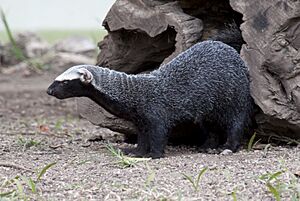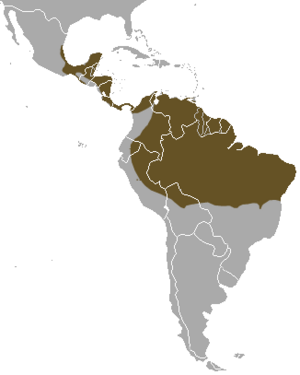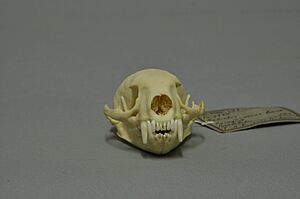Greater grison facts for kids
Quick facts for kids Greater grison |
|
|---|---|
 |
|
| Conservation status | |
| Scientific classification | |
| Genus: |
Galictis
|
| Species: |
vittata
|
 |
|
| Greater grison range | |
| Synonyms | |
|
Galictis allamandi Bell 1837 |
|
The greater grison (Galictis vittata) is a cool animal that belongs to the weasel family. You can find them living in places like Southern Mexico, Central America, and parts of South America.
Contents
What Does a Greater Grison Look Like?
The greater grison is a thin animal with short legs and a long neck. It also has a short, bushy tail. They look a lot like their close relative, the lesser grison.
You can tell them apart because the greater grison is bigger. Their body, from head to tail, is about 45 to 60 centimeters (18 to 24 inches) long. Adult greater grisons usually weigh between 1.5 and 3.8 kilograms (3.3 to 8.4 pounds). If they are raised by humans, they might grow even bigger.
Their back, sides, and the top of their head are a grayish color. The rest of their body is much darker, usually solid black. A thin white stripe runs along their head and shoulder. This stripe separates the dark and light fur. Sometimes, these two colors might blend together further down their body.
Their tail is about 14 to 20 centimeters (5.5 to 7.9 inches) long. It has bushy hair that matches the color of their back. Greater grisons have a flat, wide head with small, round ears. Their eyes are dark brown or black. Their legs are strong, and they have five webbed toes. Each toe has a sharp, curved claw.
Where Do Greater Grisons Live?
Greater grisons live in North and South America. Their home range stretches from southern Mexico all the way down to central Brazil, Peru, and Bolivia.
They like to live in many different kinds of forests. They also live in open areas called cerrado, which are like savannas. You will often see them close to rivers and streams. They usually live in places that are below 500 meters (1,600 feet) high. However, in some parts of the Bolivian Andes mountains, they can be found as high as 2,000 meters (6,600 feet). Sometimes, they even live in farms, like plantations or rice fields.
How Do Greater Grisons Behave?
Greater grisons mostly live on the ground. But they are also good at climbing trees and swimming. They are usually active during the day, which means they are diurnal. They only sometimes come out at night.
They often live alone or in pairs. Each grison or pair has a large area they call their home, which is at least 4.2 square kilometers (1.6 square miles). Because they live so spread out, it's rare to spot them in the wild. At night, they sleep in hollow logs or under tree roots. They might also use old burrows dug by other animals.
We don't know much about what they eat. But we do know they mostly hunt small animals with backbones. This includes fish, frogs, birds, and other small mammals. When they are hunting, they move in a zigzag pattern. They make short jumps and sometimes stop to look around. They also sniff the air with their heads up.
If they need to move more carefully, they press their bodies low to the ground. This movement looks a bit like a snake. If they feel threatened, they make a series of grunts. These grunts get louder and faster until they become quick barks. Finally, they might let out a loud scream while showing their teeth.
Greater Grison Biology and Life Cycle
Like many other mustelids (weasel family animals), greater grisons have special scent glands near their bottom. These glands release a yellowish or greenish liquid called musk. This musk isn't as strong as what some other animals spray. But they can spray it at attackers. They also use it to mark their territory, letting other animals know it's their space.
Female grisons usually give birth to up to four young. This happens between March and September. The babies grow inside their mother for about 39 days. When they are born, they weigh less than 50 grams (1.8 ounces). They are born blind, but they already have a short coat of hair. This hair looks just like the adult pattern.
Their eyes open after about two weeks. They start eating solid food when they are three weeks old. They grow very quickly, reaching their adult size in just four months. In zoos or special care, greater grisons have lived for at least ten years.



